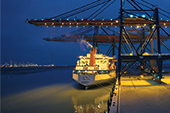Driving Growth and Employment Through Logistics
Logistics clusters create jobs that are difficult to move offshore and lead to economic growth in multiple sectors.
Topics

The Port of Rotterdam is the center of a logistics cluster that has grown to employ 50,000 people directly and another 90,000 indirectly.
Image courtesy of Port of Rotterdam.
Ever since British economist Alfred Marshall wrote about the importance of industry clusters in his classic 1920 book Principles of Economics, academics and policymakers have been trying to understand and nurture the ingredients that are essential to industrial success. In the late 1990s, business strategist Michael Porter argued that clusters make businesses more competitive by increasing the pace of innovation and stimulating new business formation. National and regional governments quickly embraced the idea that once they seeded a cluster, good things would happen: Businesses would be drawn to the area and attract employees and more employers, and these activities would feed on themselves, leading to economic growth.
In recent decades, numerous industrial clusters have developed around the world. Some of the best known are the knowledge clusters around Silicon Valley (for information technology), Hollywood (for entertainment), and Boston (for life sciences). In each case, one of the most powerful lures for companies and employees has been knowledge spillover. Strong clusters are ecosystems of venture capital resources, universities, research centers, employers, highly skilled workers and institutions for collaborations, such as chambers of commerce. There are questions, however, about the nature of the economic benefits knowledge clusters are capable of generating. While such clusters can generate employment for highly skilled engineers and scientists, for the most part they do less to directly address the problem of unemployment among less educated and less trained workers.
The Benefits of Logistics Clusters
Many economists believe that the manufacturing sector in the West will have an uphill climb because of a long-term disadvantage in labor cost and flexibility compared with developing countries. But there is another sector — logistics — where industrial clusters have a brighter long-term future.
Logistics clusters are local networks of businesses that provide a wide array of logistics services, including transportation carriers, warehousing companies, freight forwarders and third-party logistics service providers. They also include the distribution operations of retailers, manufacturers (for both new products and aftermarket parts) and distributors. These clusters attract companies for whom logistics is a critical element of their service offering or a large part of their overall costs. In recent years, logistics clusters have received support and funding from regional and national governments all across the world seeking to promote economic growth.
Logistics clusters are located strategically to enable efficient transportation and delivery services to large populations. Typically, they are positioned in mode-changing locations such as busy seaports (Rotterdam, Shanghai, Los Angeles), airport hubs (Hong Kong, Seoul, Memphis) and major intermodal yards where freight shipments transfer from railcars to trucks (such as Chicago, Dallas and Kansas City). Some of the world’s largest logistics hubs, including Singapore, São Paulo and Memphis, bring together multiple elements at once: mode-changing services, distribution to nearby populations, and transshipment services.
A Positive Feedback Loop
Logistics clusters are attractive to government officials for several reasons. After an initial seed investment, they generate a self-reinforcing positive loop — more so than most other clusters. All industrial clusters produce a chain of mostly desirable events: more companies lead to the arrival of new suppliers seeking to be close to their customers — and more employees develop skills to meet the needs of the industry. This leads to further growth, and as the cluster expands, so does its clout, leading to more favorable government regulations and perhaps public funding for training and research centers.
A logistics cluster, however, offers the potential for an especially strong positive feedback loop by virtue of its involvement in a wide array of activities that crisscross the economy. As the flow of goods into and out of the cluster increases, transportation costs decline and the level of service improves. For example, larger vehicles have a lower cost per ton-mile hauled than smaller vehicles, evidenced by the growth in the size of trucks, planes, maritime vessels and train lengths over the years. High freight flow into and out of logistics clusters allows transportation carriers to operate larger conveyances, reducing operating costs. A corollary benefit to more freight volume moving through logistics clusters is more frequent service by carriers. Better service attracts more distribution and logistics operations, which in turn generates more freight movements and attracts even more carriers.
Some of the unique drivers of growth for logistics clusters are rooted in the interchangeability of both transportation and logistics assets. Although the contents of the packages that travel through the UPS Worldport in Louisville, Kentucky, and the contents of containers in Shenzhen are varied and highly specific, the list of services required to move the cargo to the various destinations — the picking, sorting, loading, transporting, tracing, unloading and delivery operations — is very much the same. Furthermore, conveyance sizes and capacities are similar among transportation providers because of regulations and standards. The result: new distribution operations that join a logistics cluster can take advantage of the services of transportation carriers already serving it, and new transportation carriers that inaugurate a service in and out of a logistics cluster can sell their services to the full range of businesses in the cluster. Furthermore, when distribution centers are located near each other, companies can share resources, such as forklifts and warehouse space, allowing them to respond effectively to changing demand patterns.
Consider the example of AllianceTexas, a logistical hub located 40 minutes north of the downtown Dallas. The 17,000-acre development, created by the Perot family’s Hillwood Development Company LLC, includes a cargo airport and a Burlington Northern Santa Fe intermodal yard. These facilities, along with the strong highway connectivity of the region, allow AllianceTexas companies to receive bulk freight from the Los Angeles ports via rail, add value to it without incurring tax (because of a free trade zone designation) and distribute the goods to 45 million people living within one day’s trucking distance. The total investment prior to 2011 was $7.35 billion, with less than 6% coming from public sources; the rest was from private investors. So far, AllianceTexas has attracted more than 260 companies (including General Motors, Chrysler, Ford, Best Buy, Home Depot, Coca-Cola, LG Electronics, Exel and FedEx), and as of 2011 it generated more than 30,000 direct and 73,000 indirect jobs, with total economic impact of $40.6 billion.
Job creation, in fact, is one of the strongest arguments for logistics clusters. Memphis International Airport, for example, is responsible for 220,000 jobs in the local economy, 95 percent of which are tied to cargo operations. Louisville International Airport, the worldwide air hub for UPS, plays a similarly influential role for greater Louisville, employing more than 55,000 people locally. In the Port of Rotterdam, an average of 34,000 oceangoing ships and an even larger number of inland vessels arrive annually. The logistics cluster that has grown up around the port provides direct employment for more than 50,000 workers and indirect employment for another 90,000.
A major distinction between logistics clusters and other kinds of industrial clusters is the range of jobs. In contrast to Silicon Valley, Wall Street and other knowledge-based clusters, which tend to employ highly educated people with starting salaries in the top five to seven percent of U.S. workers, logistics clusters generate a diverse spectrum of blue collar, white-collar and no-collar jobs. Although logistics work may appear to involve relatively low-skill activities such as transporting boxes and driving trucks, the requirements for success are sophisticated and advanced in terms of the work processes and information technology used. Extensive operational experience “on the floor” is highly valued, even for senior executives. Thus, many logistics companies have well-established patterns of promoting from either within the organization or within the industry. To improve the overall skill level of employees, many companies provide opportunities to earn advanced certifications and degrees.
The record of UPS bears this out. A report by Accenture shows that a large majority of full-time management employees at UPS rose from non-management positions, and more than three fourths of its vice presidents started in non-management positions. In the United States, salaries for non-college-educated employees in the logistics sector are competitive with — and in some cases exceed — those in manufacturing.
Beyond Direct Logistics Employment
One advantage of logistics jobs is that they are less subject to offshore relocation than jobs in some other sectors. The economics of transportation means that cargo has to travel long distances in bulk, while demand from retailers and just-in-time manufacturers means that final distribution must be handled locally in small quantities in response to the ups and downs of customer demand. This fundamental architecture enables the global supply chain system to be responsive to changing local requirements while keeping costs down. Another advantage is that the logistics industry isn’t overly dependent on a narrow set of industries but serves thousands of businesses in multiple industries, thus making it less subject to the vagaries and business cycles of any given industry. In particular, logistics clusters provide several key benefits related to job creation.
Value additions Once products are in a distribution center, it is efficient to perform limited value-added operations on them in situ, in response to retailers’ or manufacturers’ needs. For example, every year, 50,000 Mazda cars destined for England sail past Britain to the European coast of the North Sea for final processing in Rotterdam before being delivered to the United Kingdom. UPS Supply Chain Solutions, for its part, repairs Toshiba laptops at its facility in Louisville, next to the UPS Worldport air hub, reducing service turnaround times from two weeks to four days. Many of the activities performed at logistics hubs, such as final preparation of products and creating promotional packages and displays, require specialists who are located nearby, including designers and electronics technicians.
Demand response Given the vagaries of market demand, companies often hold off on final customization of their products to maintain flexibility. This is a special type of value-added operation that can be performed in logistics clusters at distribution or fulfillment centers. It gives the shipper one last chance to modify, customize or augment the product before it is shipped to the customer. Nikon, for example, uses UPS Supply Chain Solutions in Louisville to receive photographic equipment from its factories in Asia for distribution in the Americas. Before being shipped to retailers, products are either “kitted” with accessories (such as batteries and chargers) or repackaged for in-store display in accordance with a retailer’s latest requirements.
Facilitating returns Consumer electronics customers return up to 20% of the products they buy, but only about 5% of returned items have an actual defect; most are returned for other reasons, including buyer’s remorse. Logistics clusters play an important role in repairing and refurbishing returned merchandise, a role performed by the same logistics service providers involved in distributing the new products, thereby building on existing relationships and processes.
To appreciate how logistics companies assume roles that used to be reserved for manufacturers, consider Neptune Lines, a Miami-based forwarder with operations in Panama’s Colón Free Zone. Neptune specializes in refurbishing secondhand pieces of heavy equipment for Caterpillar and Komatsu. It handles about 5,000 pieces of equipment per year. Once a bulldozer or an excavator is resold, Neptune repairs it to the manufacturer’s standards and ships it to the customer. To deliver this service, Neptune employs a team of skilled mechanics in addition to its transportation and logistics specialists.
Attracting other industries and jobs Logistics clusters often attract manufacturing businesses that need efficient transportation and logistics services, and these businesses sometimes spawn sub-clusters. Indianapolis, for example, has some 1,500 logistics and related services companies, including distribution centers for Amazon.com, Hewlett-Packard, CVS Caremark and many others. With four intersecting interstate highways, good rail connections and a busy airport, Indianapolis has already attracted a number of life science companies, including Eli Lilly and Co., WellPoint Inc., Dow AgroSciences LLC, Cook Group, Pfizer and Roche Diagnostics. Similarly, Memphis, with extensive logistics resources already in place, has emerged as a significant medical devices cluster, and Singapore has attracted an aerospace maintenance repair and overhaul cluster.
Logistics clusters have the ability to address several challenges many economies face, including the pressing need for good jobs, higher levels of foreign trade and infrastructure renewal. Although this article emphasizes job creation, logistics clusters offer other clear benefits to growth-oriented businesses. In addition to helping companies navigate global supply networks, logistics clusters can lead the way in sustainable transportation and energy-efficient storage and transportation operations. Without question, they are contributing to the efficiency of global supply chains. In the process, they are increasing international trade and global trade flows.





Comment (1)
Forum March Program: STL Regional Freightway Connects the Dots - ConstructForSTL